You may be curious about mysterious western China and want to experience the folk customs of Tibet. Then China Tour 2022 with Tibet is your best choice. You will be invited to a Tibetan family and get to know how their daily life is. Having a walk around Qinghai Lake and standing in front of the Potala Palace with reverence will make your China Tour 2022 with Qinghai Lake and Tibet unique and meaningful. You can have a closer look at Thang-ga paintings and have a better understanding of Tibetan Buddhism. In addition to having close contact with Tibet, you can have a China tour 2022 to Hong Kong, enjoying the most prosperous city of China. Weaving through the crowd and looking at the scene of hustle and bustle will bring you back from the fairyland in western China to the mortal world.

Welcome to Shanghai! You can start your China Tours 2022 here and have an impressive tour. After your arrival, your tour guide will pick you up and take you to the hotel where you can have a good rest. Shanghai is an economic and financial center in China. Being here, you will have a chance to feel how prosperous this charming city is.
In the morning, your tour guide will take you to Jade Buddha Temple. In 1882, Master Huigen from Mount Putuo went to the Buddhist holy land, Tianzhu(ancient India), to pilgrimage. When he passed by Myanmar, he found a precious jade and carved it into 5 jade Buddha statues under the sponsorship of local overseas Chinese. Later, he decided to take the jade Buddha statues back to Mount Putuo and left a sitting Buddha and a reclining Buddha in Shanghai. Therefore, Jade Buddha Temple was built in 1900 to enshrine the two jade Buddha statues. Jade Buddha Temple is an architecture modeled after the Song Dynasty (960-1279) building style. Although the temple is located in the busy downtown, it remains quiet amid the noisy bustle. This attraction is regarded as a holy land and residents will come to this place and find their inner peace.
After enjoying the calmness that the Jade Buddha Temple brought to you, you can go to the Yu Garden (closed each Monday). Yu Garden was a private garden built in the Ming Dynasty (1368-1644) with a history of about 400 years. Its owner was Pan Yunduan, an official in charge of finance and administration in the Ming Dynasty. He spent 20 years building this garden and named it Yu, which means safety and happiness in Chinese. If you look at the map of the garden, you will find that the shape of it looks like the letter “F”. Being inside the garden, you will be surrounded by lakes, rockeries, and all kinds of exotic flowers as well as rare herbs. There is a must-visit place in the garden, Nine-Dragon Pond. It is called Nine-Dragon Pond, but actually, there are only four stone-carved dragons. Then why the pond got this name? If the four inverted reflections in water and the wriggled river which looks like a dragon are counted, then there will be nine dragons. Take your time in the Yu Garden and have a walk around it, and you will have a deeper understand of the ancient Chinese garden.
After lunch, you will go to visit Shanghai World Financial Center. Shanghai World Financial Center is located in Lujiazui Finance and Trade Zone, one of the most prosperous areas in Shanghai. This skyscraper, as one of the ten tallest buildings in the world, towers into the clouds with a height of 492 meters. It has 101 floors on the ground and 3 floors underground. You may worry that with this height, whether it will be safe when encountering typhoons, especially in the rain season. Two wind dampers were put on the 90th floor with a weight of 150 metric tons. The dampers are used to prevent the building from shaking when a strong wind comes. You will be safe no matter what weather it is.
Your next destination is the Bund. The Bund is located at the riverside of the Huangpu River, the mother river of Shanghai. As a Chinese historical and cultural area, the Bund is home to 52 classical buildings with various styles, which have witnessed the development of modern Shanghai. There is one building worth mentioning, which is Asia Building. Asia Building was built in 1916 with 7 stories. It was the tallest building in the Bund at that time. After Shanghai opened as a commercial port, this building was bought by a British businessman, McBain. Therefore, it was also called McBain Building at that time. Now the headquarter of China Pacific Insurance Company is located in the Asia Building. Besides this building, you can walk along the Bund and visit other buildings with various styles.
Your last stop today is Nanjing Road, the most popular attraction for shopping and food lovers. Nanjing Road refers to Nanjing Road Pedestrian Street, which was built in 1999 with a length of 1,033 meters. Wooden chairs, shopping booths, advertising boards, street lamps, waste bins, and other public facilities can be seen everywhere. You can go to various shops here which sell both fair-price products and luxuries, including folding fans, chopsticks, and silk. The traditional foods here are what you can’t miss. You must try the fresh pork mooncakes and smoked fish of Laodafang Food Store. I’m sure you will be amazed by their tastes. If you like to watch movies, then the Grand Theater is a must-see place. It is the first theater in the East Asia, which witnessed many firsts of Asia. It is the first theater that used air conditioning in Asia. It is also the first stereo theater and played the first sound film in Asia. There is much first time to be listed. I can assure you that this visit will greatly widen your horizon and make your Shanghai tour 2022 colorful.
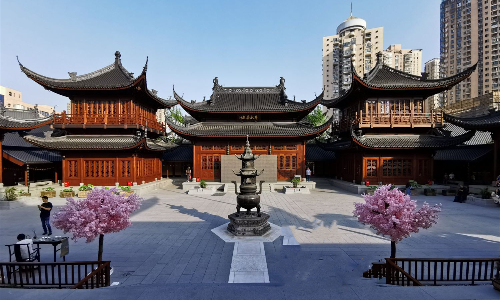

 Xining
Xining After a wonderful day in Shanghai, you will go to Xining. After breakfast, you can pick up your luggage and go to the airport. Your tour guide will wave goodbye to you after you check in at the airport. You will take the estimated flight MU9925 10:50/14:35 to Xining. Upon your arrival, your tour guide will be holding a name sign and waiting for you at the arrival lobby. He will take you to the hotel reserved for you. You can have a good rest there and get ready for the journey tomorrow. Xining is the capital city of Qinghai Province with an area of about 7,660 square kilometers. It is the doorway in the east of Qinghai-Tibet Plateau, the biggest plateau in China. Xining has a long history and rich natural resources. Therefore, it is called a brilliant pearl on the Tibet Plateau.
 Qinghai Lake
Qinghai Lake Your first stop in Xining is Ta’er Monastery. After breakfast, we will drive southwest for about 30 minutes to get to Ta’er Monastery, which is about 28 kilometers away. Ta’er Monastery was built in 1379, acting as a center for Tibetan Buddhism in the northwest of China. The central governments of various dynasties had admitted its religious position. Emperor Kangxi and Emperor Qianlong of the Qing Dynasty (1636-1912) used to visit here and left inscriptions. Butter sculpture, wall paintings, and barbola are called three unique arts which could only be seen in Ta’er Monastery. Many Buddhist texts and academic monographs about history, literature, philosophy, medicine, and law-making are stored in the monastery. I believe you will know better about Tibetan Buddhism after visiting.
After lunch, we will drive west to Qinghai Lake. It will take us about 2 hours and a half to get to this place which is 145 kilometers away. Qinghai Lake lies in the northeast of Qinghai-Tibet Plateau. Its Tibetan name is Cuowenbu, meaning cyan sea. Qinghai Lake is the largest saltwater lake in the inland of China. It is said that this lake has a history of more than 2 million years. Qinghai Lake covers an area of 4,543 square kilometers. Many legends are going about Qinghai Lake. It is said that more than 1000 years ago, the Tang Dynasty (618-907) and Tubo Kingdom (633-842, the Tibetan regime at that time) established diplomatic relations by the marriage of Princess Wencheng and Srongtsen Gampo, the king of Tubo. Before Princess Wencheng went to Tubo, the Emperor of the Tang Dynasty gave her a mirror that can show the scene of Chang’an (ancient Xi’an, the capital at that time), the princess’s hometown. On the way to Tubo, Princess Wencheng opened the mirror and saw Chang’an. Her eyes were instantly filled with tears. However, she didn’t forget her responsibility. She threw the mirror to the ground in case of being cowardly when she was homesick. As soon as the mirror dropped to the ground, it became Qinghai Lake.
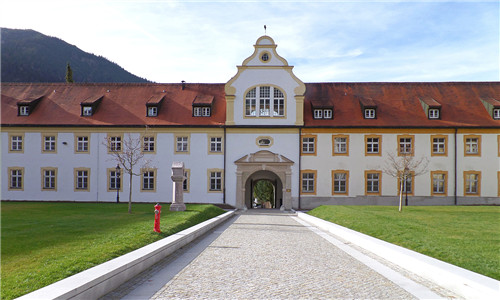
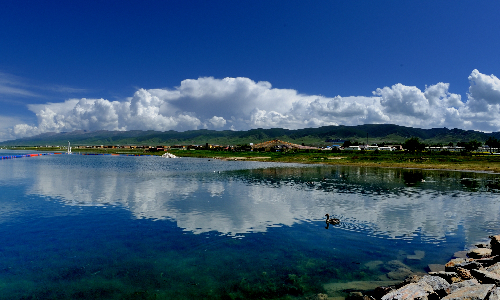
 Golmud
Golmud Today we will go to Golmud. We will spend about 9 hours on the way. Golmud is 680 kilometers away, located in the southwest of Qinghai Lake. Since it is a long journey, I suggest that you should bring some snacks. If you are not tired, you can take a look outside. You will feel amazed at how beautiful the scenery is along the way. The prairie stretches as far as your eyes can see. The flocks and herds eat the grass at leisure. The blue sky and white clouds add radiance and beauty to each other. If you opened the window, you will feel how fresh the air is for there is barely any pollution here. In most people’s minds, this place is a fairyland far away from the busy bustle and heavy pollution. If lucky, you may also see an eagle soaring in the sky.
 Tuotuo River
Tuotuo River In the morning, we will get up early to visit the Tuotuo River. We need to drive southwest for about 7.5 hours to get to Tuotuo River, which is about 400 kilometers away. Tuotuo River is in the south of the Hoh Xil Mountains. The river is only 3 meters wide at this headstream with a depth of 20 centimeters. Tuotuo River means the red river in Mongolian. Since hundreds of years ago, people have been researching the source of the Yangtze River. Xu Xiake, a famous traveler of the Ming Dynasty believed that the Jinsha River (the upper reach of the Yangtze River) is a source of the Yangtze River. However, in the exploration in 2010, scholars finally ascertained that Dangqu River is one source of Yangtze River and Tuotuo River is its western source.
After lunch, you will have a chance to see the First Bridge of the Yangtze River. It was originally a wooden bridge. As time goes by, the bridge was rebuilt three times. In 1950, when the wooden bridge was first built, it was regarded as the lifeline for Tibetan people. At that time, this 7-meter-wide wooden bridge is the only way to pass by the river. The bridge played an important role in linking Tibet and other parts of China. Now, this bridge was larger and solider. It is located at an altitude of 4,600 meters with a monument erecting beside the bridge.
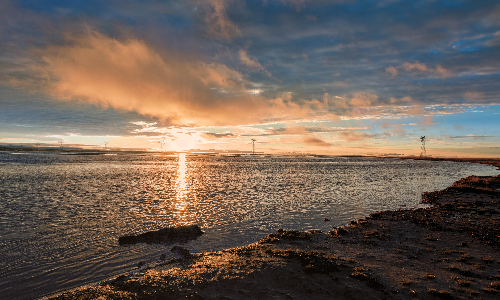
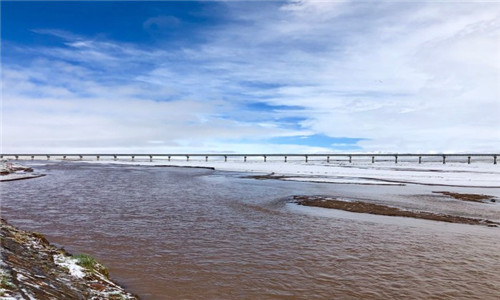
 Nakchu
Nakchu After breakfast, we will drive southward for about 8 hours to the 420-kilometer-away Nakchu. Nakchu is the northern gate of Tibet. Nakchu has the characteristics of chillness, oxygen shortage, and a large difference in temperature between day and night. Remember to bring some clothes in case of meeting cold weather. On the way to Nakchu, we can stop at Tanggula Mountain for a visit. Tanggula means mountains on the plateau in Tibetan. It is also named Warehouse of Snow and Wind for constant snows and winds all year round. Tanggula Mountain has an altitude of about 6,000 meters with Hoh Xil No Man’s Land lying at the foot of it. Many endangered animals like Tibetan antelope inhabit here. Tanggula Mountain acts as a natural boundary between Tibet and Qinghai Province. However, the weather here is unstable. Even in summer, the highway may be blocked because of strong wind and heavy snow. If you come to this place, you can proudly call yourself a hero because high altitude has made this place almost a forbidden zone for humans, and not everyone has the courage to challenge his extreme.
When you arrive at Nakchu, your tour guide will help you check in at the hotel. You can try to adapt to the altitude. If you feel sick, contact your tour guide immediately and he will help you to the utmost of his capacity.

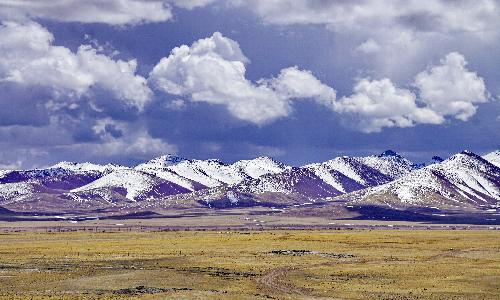
 Lhasa
Lhasa After breakfast, you will leave for Lhasa. We will drive southwest for about 4 hours from Nakchu to Lhasa, which is 340 kilometers away. On the way, we will first stop at Namtso Lake. Namtso means lake from heaven in Tibetan. It is also regarded as one of the most famous Buddhism holy lands. There is a legend about Namtso Lake and Nyenchenthanglha Mountains. It is said that Namtso and Nyenchenthanglha used to be a loving couple living in the beautiful Northern Tibetan Plateau. One day, Nyenchenthanglha went to another pasture to look for missing sheep and met a young girl, Yamdrok Yumtso. Nyenchenthanglha fell in love with the girl and forgot everything including his beloved wife. Namtso worried about her husband and cried day and night, finally turning into a lake. With time passing by, the husband remembered his wife and regretted being like this. He became snow mountains to accompany his wife. And the lonely girl he left turned into Yamdrok Yumtso Lake. This legend has given this place an air of mystery.
Our next stop is Yangpachen Geothermal Energy. Yangpachen Geothermal Energy has an altitude of 4,300 meters, located in Yangpachen Town. There are rich mine resources such as tephra, terrestrial heat, peat, and bolus alba in this area. Various wild animals such as river deer, lynxes, Mongolian gazelles, and wild yaks can be seen here. By now, it has a population of 6,233 people. We come here to see the amazing geothermal energy that is available here. Thanks to its rich geothermal resources, there are very many natural high-temperature hot springs in the area. The perfect fit of the molten hot springs of Yangpachen surrounded by snow-capped mountains makes for a fascinating natural spectacle on the roof of the world.
When you arrive in Lhasa, your tour guide will take you to a comfortable hotel. You can fully relax and look forward to tomorrow’s journey. Lhasa is a political, economic, cultural, and scientific center in Tibet. At an altitude of 3,650 meters, it has sunny weather all year round with a sunshine duration of 3,000 hours per year. Therefore, Lhasa is also known as Sun City. Its unique geographical conditions make this place full of natural resources. Its gorgeous scenery, long history, and special customs also make people impressed. By visiting Tibet in 2022, you will build a closer tie with nature.
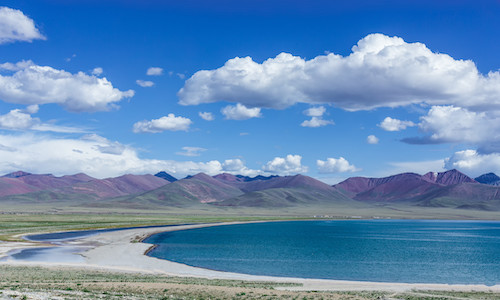
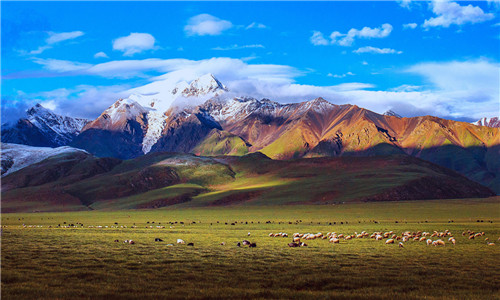
In the morning, you will go to the Potala Palace. Potala Palace is a palatial architectural complex. It is located at an altitude of 3,700 meters with an area of 360,000 square meters. It looks like having 13 stories outside but has only 9 stories inside. Palaces, ancestral halls, Buddha halls, and scripture halls are all included here. Potala Palace consists of White Palace and Red Palace. It is said that this palace was built by Srongtsen Gampo, king of the Tubo Kingdom (the Tibetan regime at that time) to propose to Princess Wenchen of the Tang Dynasty. Srongtsen Gampo had shown his talents in his teenage years and after strict training in riding, shooting, swordsmanship, and martial art, he became a hero of the Tibetan people. He deeply knew that the development of Tibet was lower than the Tang Dynasty. Therefore, he learned modestly from Tang’s culture and system, and proposed to Princess Wencheng to bring peace to both Tibet and the Tang Dynasty. Potala Palace was built to show his sincerity to marry the princess.
In the afternoon, you can visit Jokhang Temple. Jokhang Temple was also built by Srongtsen Gampo. It is a Tibetan Buddhism temple, meaning Buddha Hall in Tibetan. Jokhang Temple was built 1,300 years ago, having a supreme position in Tibetan Buddhism. This temple has integrated the architecture style of Tibet, the Tang Dynasty, Nepal, and India. The pious believers kowtow in front of the temple to show their piety. The place where Jokhang Temple is located used to be a lake. Srongtsen Gampo promised Bhrikuti Devi (one of his wives), Princess of Nepal that he would build a temple where his ring fell. The ring exactly fell into a lake. Therefore, Srongtsen Gampo collected materials and ordered workers to build Jokhang Temple upon the lake. You can have a tour around the Hall of Maitreya Buddha, Hall of Guanyin Bodhisattva, and Hall of the Three Dharmas inside the temple. Have a closer look at the Buddha statues in the hall and you will know better about Tibetan Buddhism.
Your next destination is Barkhor Street. Barkhor means circumambulation in Tibetan. This street is a famous circumambulation and commercial center in Lhasa. Barkhor Street appeared with the development of Jokhang Temple. It has a history of more than 1,300 years. Businessmen, pilgrims, and vagrants from Mongolia, Nepal, India, and the Kingdom of Bhutan came here and this street developed into a block integrating shopping, commerce, sightseeing, religion, and folk customs. There are more than 120 handicraft shops, and 200 stalls where you can buy copper Buddha, prayer wheel, butter lamps, scriptures, prayer beads, and other religious articles as well as articles of daily use, such as aprons, harnesses, and leather bags. You can also buy some local souvenirs such as Thangka paintings, hats, and handkerchiefs. Some Tibetan snacks will also be good choices. If you don’t like local food, there are various cuisines to choose from, which will satisfy your taste bud.

Today, after breakfast, your tour guide will take you to Tibet Museum (closed each Monday). It was built in 1999. The museum consists of two parts, exhibition halls and cultural relics storage. The exhibition halls show the objects used by Tibetan people in the Old Stone Age, the Neolithic Age, Bronze Age, and Iron Age. These objects present how Tibet stepped into civilization. Patra, scriptures written on Birch Bark, and binary pottery pots are exhibited here, telling the development story of Tibet. Thangka paintings are what you can’t miss if you visit the museum. Thangka is a unique art of painting in Tibetan culture. The paintings exhibited here refer to history politics, culture, and social life. Although the paintings were created a long time ago, their colors are still bright. The materials used in Thangka creation are from nature, which ensures its bright color will remain for a longer time. Tibet Museum used to exhibit the longest Thangka painting with a length of 628 meters. I hope you can know more about Tibetan culture and history during your Lhasa tour in 2022.
In the afternoon, your tour guide will accompany you to Sera Monastery. Sera Monastery was built in 1419, located at the foot of the Serauzi Mountain. The monastery is surrounded by willows. There are hundreds of thousands of Buddha statues stored in the Sera Monastery, mostly made in Tibet and many taken from the inland of China or India, among which the most famous one is the Hayagriva King Kong Buddha Statue. There are also many colorful wall paintings inside the monastery. The Tsochin Hall is the largest hall in Sera Monastery. It was built in 1710. Tsochin Hall has 4 stories with a square in front of it. Besides, there are also two legends about the name of Sera Monastery. One is that when the monastery was being built, it started to hail. Sleets pronounce like Sera in Tibetan. Therefore, it was named Sera Monastery once it was finished. Another one is that this monastery was built in a place where roses bloomed. The pronunciation of rose is also Sera in Tibetan.
Our last destination today is Norbulingka Park. It was built in the 1740s for Dalai Lama to spend the hot summer and handle affairs. Norbulingka Park is a typical Tibetan garden. The whole garden has more than 100 kinds of plants, not only the commonly seen flowers but also some rare flowers imported from abroad. Norbulingka Park is surrounded by trees with Tibetan architecture and lakes dotted among the trees. The fresh air and quiet environment will bring a brand-new experience to you. There is a statue of four animals put inside the park. This statue is 13.69 meters high and 6.5 tons, representing unity and friendship. This statue originated from a Buddhism story in India. It is said that an elephant was resting under a tree to avoid the heat. Later, a rabbit, a monkey, and a bird came here. They argued about who should be the one to enjoy the cool under the tree. Every animal had its reason to be here. Then a stylite came and suggested to them that they should sit on each other according to their size and enjoy it together. This story tells us that everyone could live better in a peaceful and friendly world.
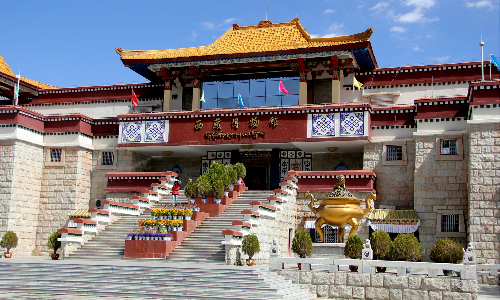

 Gyangtse
Gyangtse Today, we will leave Lhasa and drive southwest for about 5 hours to Gyangtse which is 300 kilometers away. On the way, we will stop at Yamdrok Yumtso Lake for a visit. Yamdrok Yumtso Lake means Jasper Lake in Tibetan. Yamdrok Yumtso Lake has an altitude of 4,414 meters with an area of 675 square meters. The blue lake is peaceful, looking like a sapphire mounted on the plateau. The local Tibetan people praised Yamdrok Yumtso Lake as the fairyland in the sky. The lake is a part of a fertile plateau pasture with rich water and grass resources. At the beginning of summer, shepherds will take their herds to the small islands in the middle of the lake where the animals can enjoy the grass at leisure. In winter, shepherds and their livestock will return. You can enjoy the beautiful natural scenery here and immerse yourself in nature. After the visit, we will go on the journey and check in the hotel as soon as we arrive at Gyangtse.
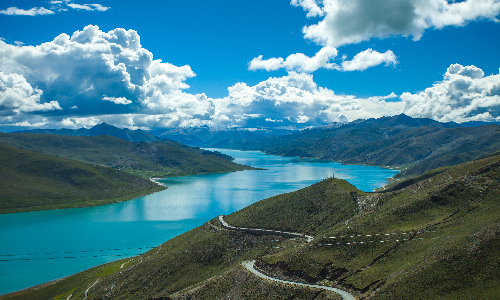
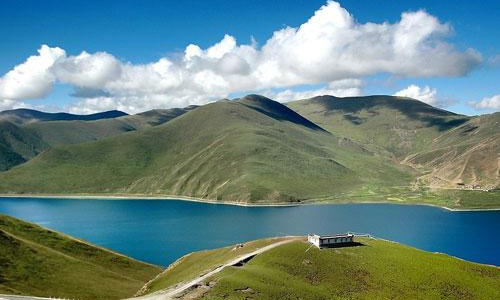
 Shigatse
Shigatse In the morning, we will visit Pelkor Monastery. Pelkor Monastery was first built in 1427 and finished building in 1437. It is a typical Tibetan Buddhism architecture integrating temple halls and pagoda. Pelkor means auspicious in Tibetan. This monastery consists of a multi-gate pagoda, temple halls, dratsang (the school of Tibetan Buddhism), and enclosing walls. You can appreciate the wall paintings here which refer to Exoteric Buddhism (one of the Buddhist sects) and historical figures.
Then we will drive northwest for about an hour and a half to Shigatse, which is 94 kilometers away. Upon our arrival, we will go to visit Tashilunpo Monastery. Tashilunpo Monastery was built in 1447, meaning a blessed monastery in Tibetan. It has about 3,600 rooms, covering a total area of 150,000 square meters. This architecture integrates the traditional architectural style of Tibet as well as the Buddhism characteristics. The Main Assembly Hall is one of the earliest buildings here and can accommodate 3800 at the same time. All the monks in the monastery sit in meditation here every day. On the internal walls of the hall, there are thousands of niches carved to enshrine Buddha statues. Prayer flags are hanging from the beams of the house, which slowly flutter in the room with the cool breeze blowing in from the windows.
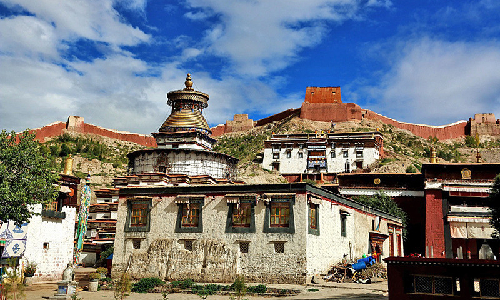
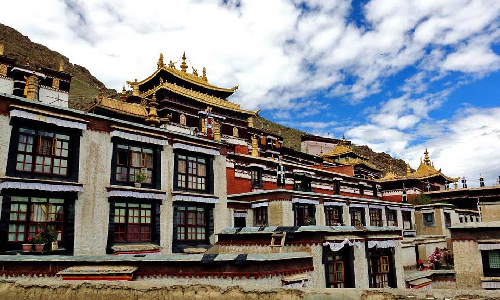
 Lhasa
Lhasa Today, we will return to Lhasa, which is 270 kilometers away. We will drive eastward for 4 hours and a half. On the way back, we can go to visit a local Tibetan family. Tibetan people are very hospitable. Once you enter their house, they will offer Hada (a piece of silk) to welcome you. You will have the opportunity to savor ghee tea(made from ghee and strong tea), highland barley wine and zanba(roasted highland barley cake).
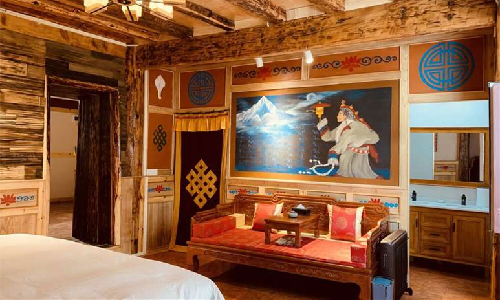

 Chengdu
Chengdu After breakfast, your tour guide will escort you to the airport and say goodbye to you. You’re going to take the estimated flight CA4402 10:15/12:20 to Chengdu. Once you arrive, your tour guide will pick you up and take you to the cozy hotel. You can unpack your luggage and have a sweet sleep at the hotel. If you need any help, please contact us.
Our first destination in Chengdu is the Chengdu Research Base of Giant Panda Breeding. As the national treasure of China, cute pandas are popular among people all over the world. Chengdu Research Base of Giant Panda Breeding was built to help them breed and save the endangered pandas. This research base has also worked with other zoos abroad such as Zoo Atlanta, and Madrid Zoo in Spain. During the last 19 years, this research base has received more than 100,000 middle and primary school students from home and abroad, letting more people know pandas’ habits. In Chengdu Research Base of Giant Panda Breeding, you can see the adult pandas as well as the baby pandas. The giant panda kitchen will show you the materials used to make pandas’ food, such as fruits, bamboo shoots, and steamed cornbread made especially for giant pandas. Visiting panda in 2022 will make your friends and families jealous of your journey.
Then we will head to Du Fu Thatched Cottage. Du Fu Thatched Cottage was the residence of Du Fu, a great poet of the Tang Dynasty. He had lived here for 4 years and created about 240 poems. Du Fu was born in the low ebb of the Tang Dynasty. At that time, the emperor was incompetent, and the people lived in hardship. Du Fu wanted to be an official to help people live a better life, but he didn’t want to go along with other officials in their evil deeds, so he was repeatedly demoted, and finally resigned and lived in Chengdu. Therefore, most of his poems reflect the social situation or satirize the corrupt officialdom at that time.
In the afternoon, we will go to Chengdu Wuhou Shrine Museum. This attraction consists of the Hui Mausoleum, Zhaolie Temple, Wuhou Shrine, and Sanyi Temple. If you come here, the Ming Stele is a must-visit. The stele was built in the Ming Dynasty (1368-1644) and the inscription was written by Zhang Shiche, a Ming official to praise the achievements of Liu Bei, emperor of the Han Dynasty. There is a Bixi in the shape of a turtle which is said to be one of the sons of the dragon under the stele. The legend goes that everything will go well if you touch Bixi’s head.
Our next stop today is Jinli Street. Jinli Street was opened to the public in 2004. The dwellings, inns, and shops are well arranged there with stone slab street meandered forward. The street is next to the Wuhou Shrine with a length of 350 meters. If you are a gourmet, then the local Sichuan cuisine, wines, and teas will make you satisfied.


 Guilin
Guilin After breakfast, you can pack your luggage and go to the airport. Your tour guide will help you check in. Then you will take the estimated flight CA4764 11:20/13:05 to Guilin. Your tour guide will be waiting for you at the arrival lobby and escort you to the hotel.
In the morning, we will drive southeast for about 1 hour to Mopanshan Wharf, which is 35 kilometers away. And then we will take the Li River Cruise for 4 hours. You can appreciate the scenery along the way. It is worth mentioning that a part of the scenery here is printed on banknotes of 20 Yuan. You can take a picture here holding the 20 Yuan. You are going to have lunch on the cruise ship while appreciating the splendid scenery.
In the afternoon, you can go to Yangshuo West Street. It was built in 1674, located at the center of Yangshuo Ancient Town. It is the oldest and the most prosperous street in Yangshuo. The ancient pavilions, temples, Ancient City Walls of the Ming Dynasty, and former residences of celebrities are well-preserved. Sun Yat-sen, a great pioneer of Chinese democratic reform delivered a speech here and leaders of 150 countries have visited this place. If you have a liking for shopping, Yangshuo West Street is a must-visit place. You can buy various kinds of souvenirs such as Chinese paper-cuttings, couplets, and Cheong-sam here as presents to your friends.

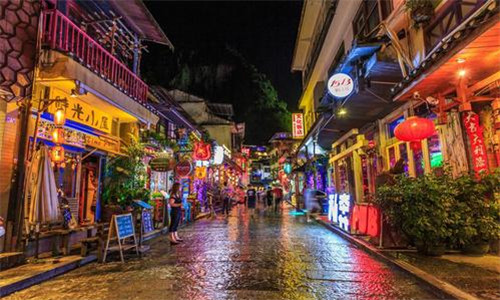
 Hong Kong
Hong Kong After breakfast, your tour guide will accompany you to the train station. You will take the estimated train G319 12:38/15:57 to Hong Kong. Hong Kong is located in the south of China. Hong Kong has a population of 7.47 million people with a land area of 1106.66 square meters. It enjoys the reputation of food paradise. You can taste various delicious foods here, including Cantonese cuisine, Sichuan cuisine, Sushi from Japan, barbecue from South Korea, and fried rice from Singapore. Your tour to Hong Kong in 2022 will round off your China tour.
After breakfast, you will go to Victoria Peak. Here you will take the Peak Tram to get to the peak. Victoria Peak is a famous attraction integrating sightseeing, entertainment, and shopping. Standing at the top of the mountain with an altitude of 429 meters, you can have a panoramic view of Hong Kong. You can overlook Victoria Harbor and Kowloon here. The Peak Tower on the peak was designed by British Terry Farrel. Some precious pictures of Hong Kong in early times can be seen in the tower, which will help you learn the history and development of Hong Kong.
Then, you will head to the Stanley Market. It is well-known at home and abroad. Shops are seen everywhere, selling Chinese handicrafts, postcards, traditional Chinese clothes, oil paintings, and so on. The traffic here is convenient. If you would like to visit here again by yourself, the bus and Aqua Luna (ferryboat) could be your choices.
Our last destination today is Repulse Bay. Repulse Bay is called the first bay in the world and enjoys the reputation of Hawaii in the East. The bay is in the shape of a crescent moon. Its name originated from a British warship that was used to repulse pirates, and this warship’s name was Repulse. Here you could lie down on the beach and enjoy the sunshine. You will feel the unique charm of this place, which will bring you a moment of calmness.


Today is your last day in China. After breakfast, your tour guide will take you to the airport and help you check in. I hope you have a good trip and welcome to China again. See you!
Editor: Chi Mengdi
Proofreader: Summer Hou
| City | Five Star hotel list | Four Star hotel list |
|---|---|---|
| Shanghai | Ocean Hotel Shanghai | Courtyard by Marriott Shanghai Central |
| Xining | Sofitel Xining | Holiday Inn Xining Hot-Spring |
| Lhasa | Shangri-La Hotel Lhasa | Thangka hotel |
| Chengdu | Sofitel Chengdu Taihe | Holiday Inn Express Chengdu Jinniu |
| Guilin | Lijiang Waterfall Hotel | Guilin Bravo Hotel |
| Yangshuo | Yangshuo Greenlotus Hotel | New Century Hotel |
| Hong Kong | Harbour Grand Kowloon | Harbour Plaza North Point Hotel |
| Other Cities | Guest House | Guest House |
 |
![]() About your child or infant, please contact us for a discounted price.
About your child or infant, please contact us for a discounted price.



We started with a few days in Beijing & ended in Shanghai, from where we visited the Forbidden City and Great Wall. In between we visited Terra Cotta Warriors Museum, Panda Base, Shanghai Disneyland.

We had a wonderful holiday in China which will remain long in the memory. China is a breathtakingly beautiful country full of splendid temples and palaces, mountains and rivers, peaceful rural scenes and bustling shopping streets.
 QUICK ENQUIRY
QUICK ENQUIRY